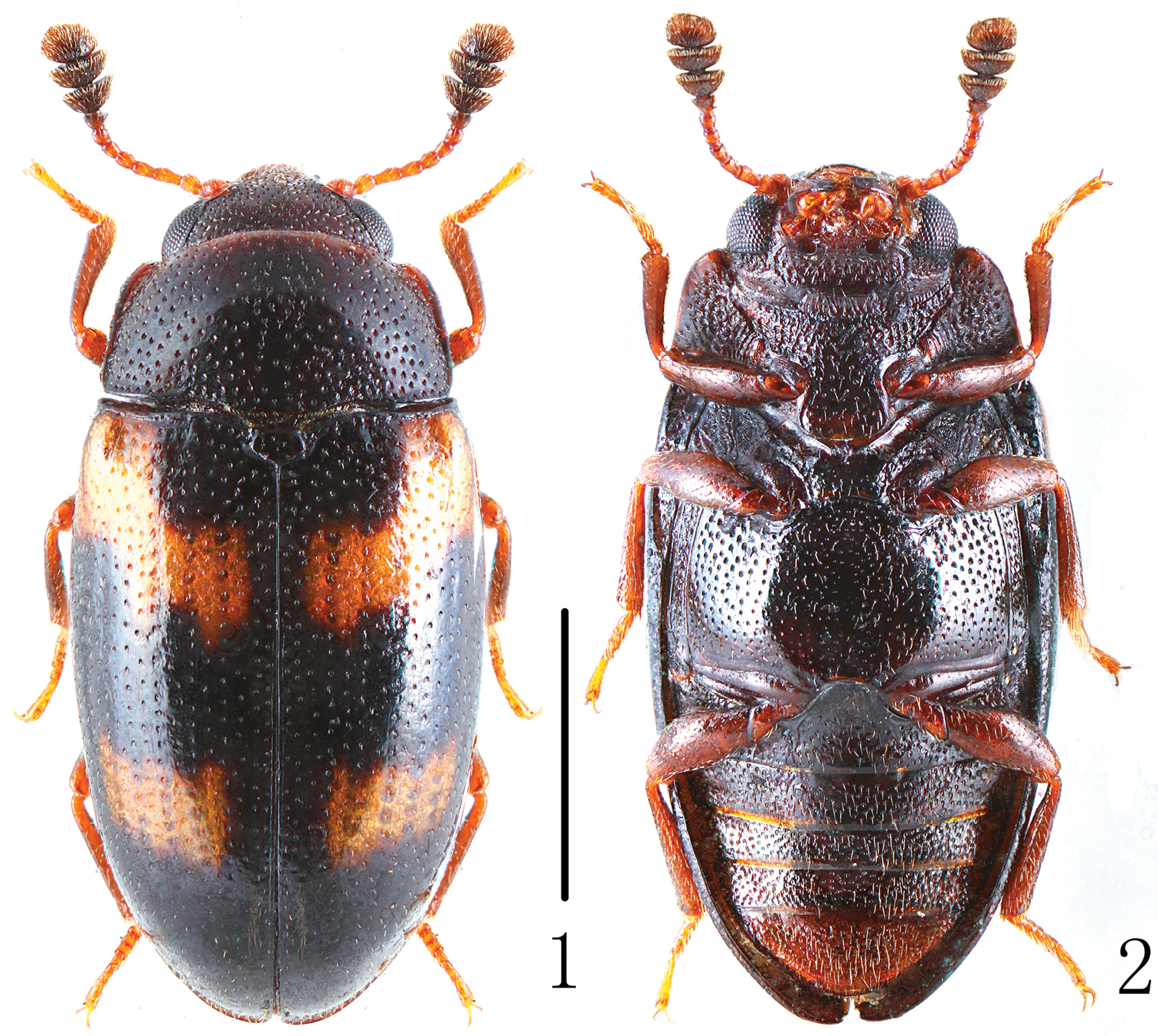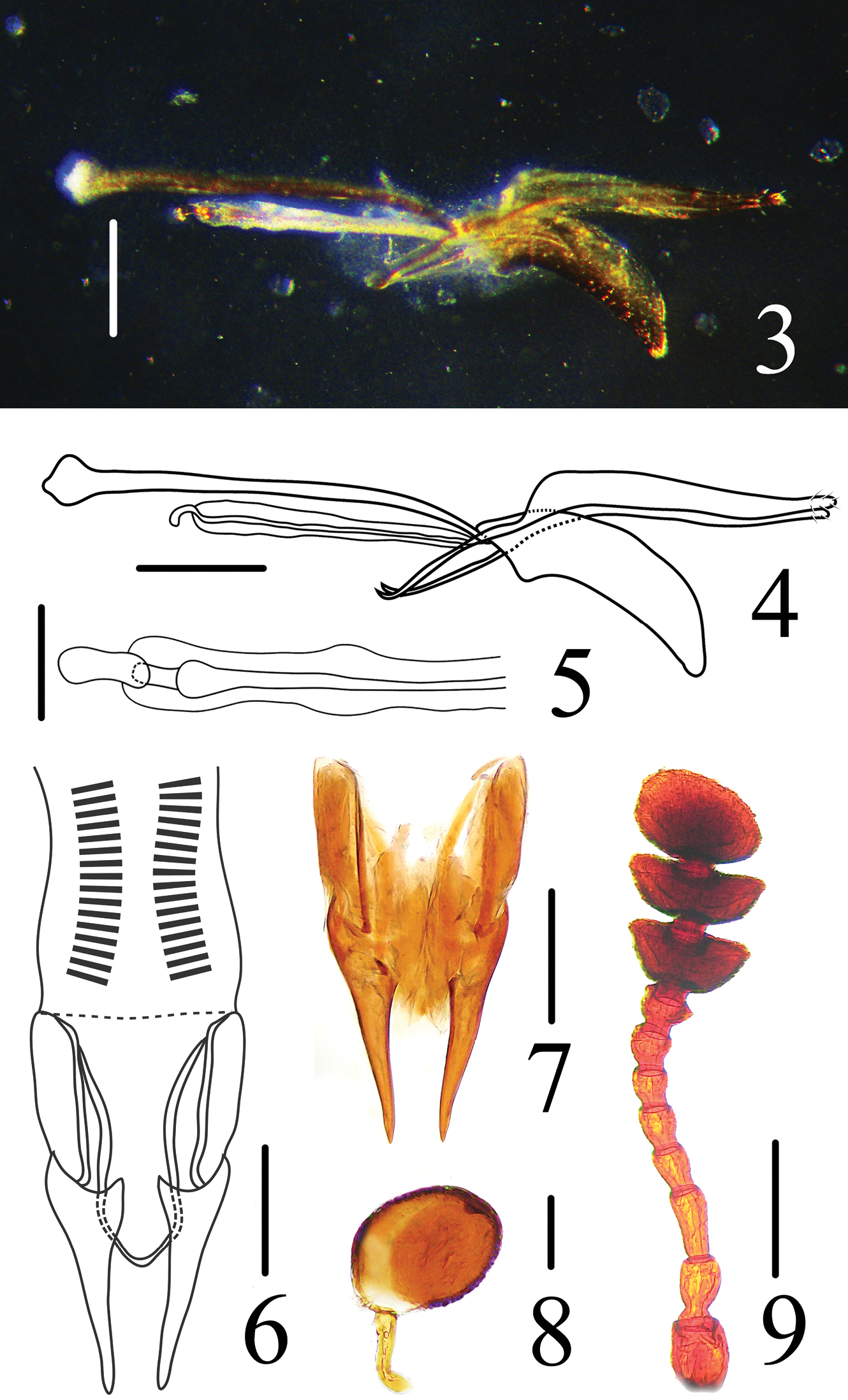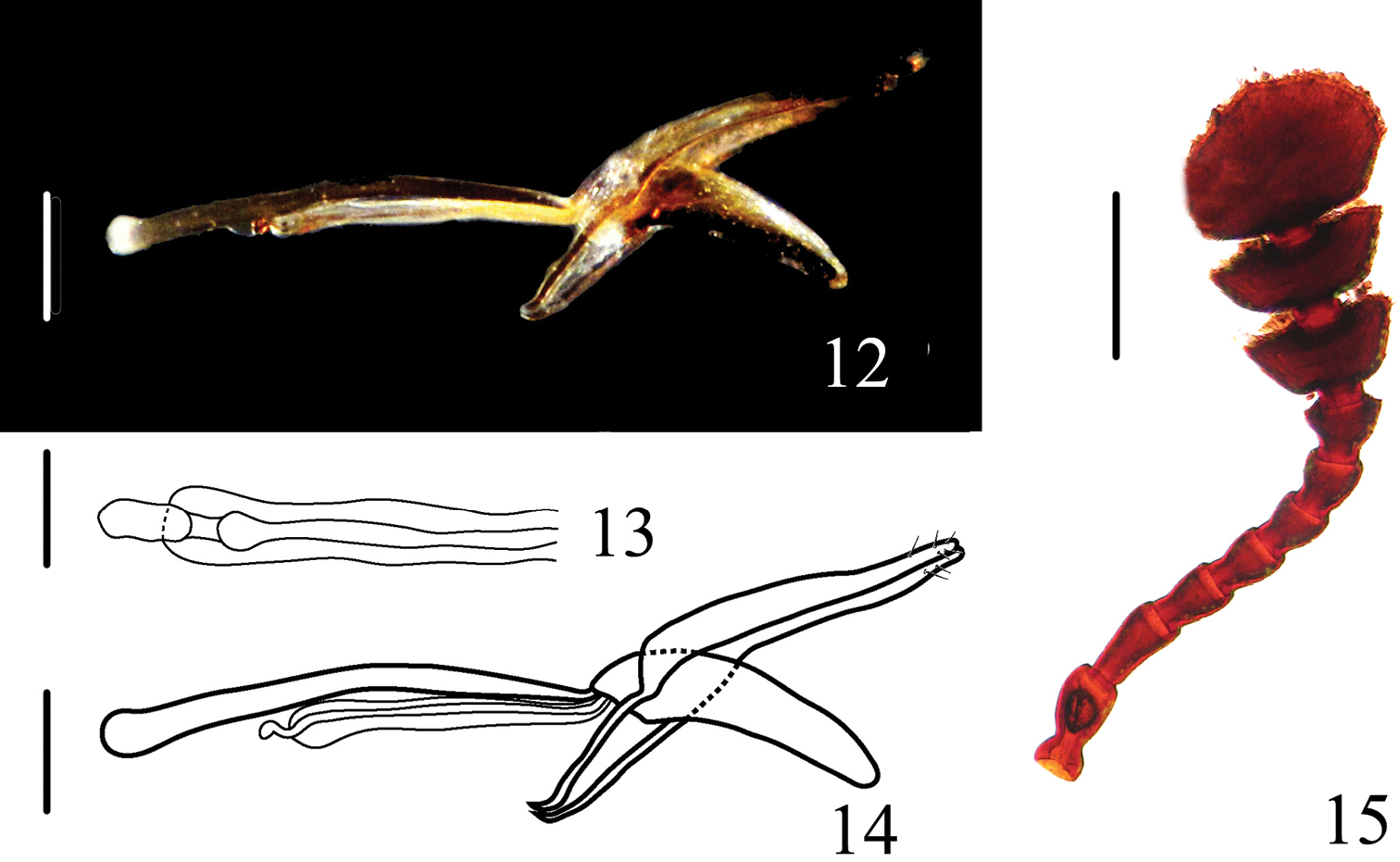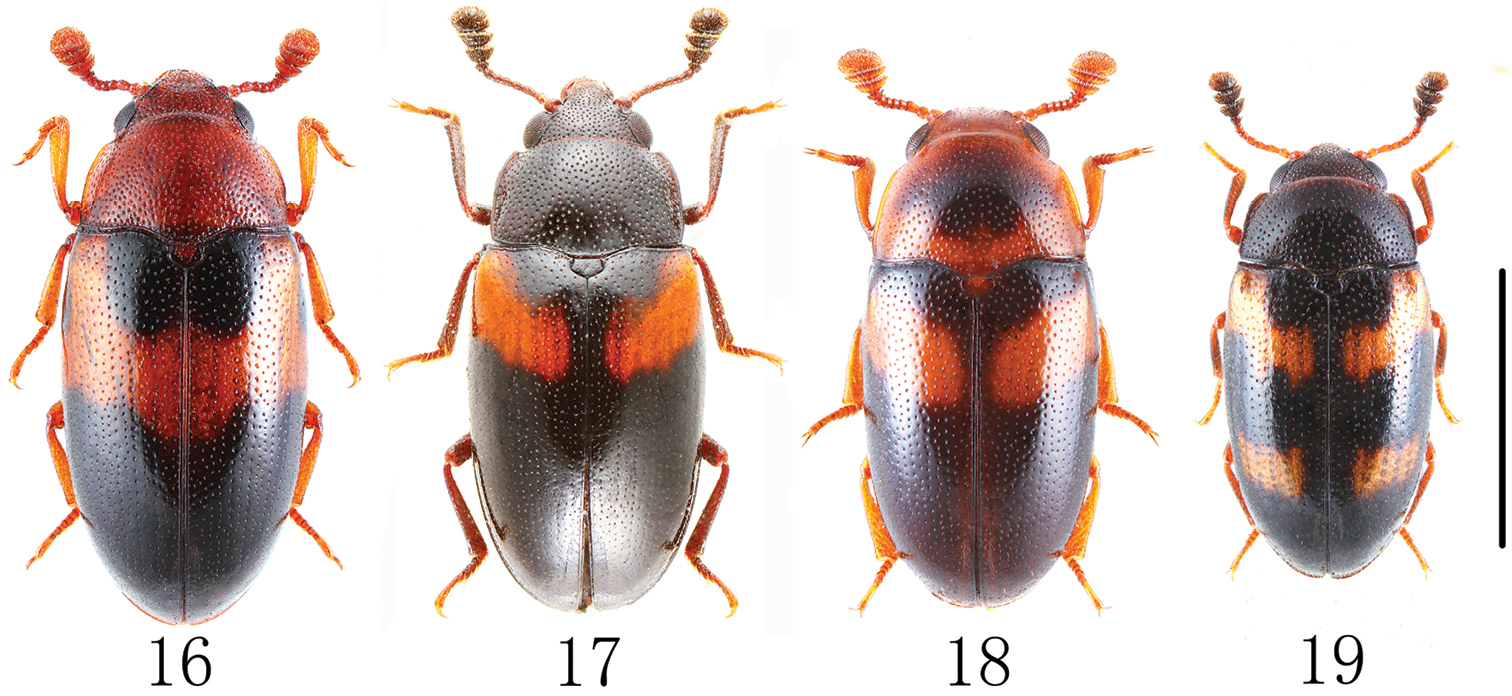






(C) 2013 Cong-Chao Dai. This is an open access article distributed under the terms of the Creative Commons Attribution License 3.0 (CC-BY), which permits unrestricted use, distribution, and reproduction in any medium, provided the original author and source are credited.
For reference, use of the paginated PDF or printed version of this article is recommended.
Two new species Dacne (Xenodacne) tangliangi sp. n. andDacne (Xenodacne) hujiayaoi sp. n. are described from China. A key to Chinese species and subspecies of genus Dacne Latreille is provided.
Coleoptera, Erotylidae, Dacne, Xenodacne, identification key, new species, China
The genus Dacne Latreille is considered to be one of the most primitive members of the subfamily Erotylinae (
In thus work, two new species of the genus Dacne are described and illustrated: Dacne (Xenodacne) tangliangi sp. n. and Dacne (Xenodacne) enodacne) hujiayaoi sp. n.from Yunnan Province, China.
The specimens examined in this paper were collected in a wide variety of woodland fungi, in crevices under bark or in other retreats by splitting and sifting. For an examination of the male genitalia, the abdominal segments were detached from the body after softening in hot water. The aedeagi, together with other dissected parts, were mounted in Euparal (Chroma Gesellschaft Schmidt, Koengen, Germany) on plastic slides. Photos of sexual characters were taken with a Canon G9 camera attached to an Olympus SZX 16 stereoscope; habitus photos were taken with a Canon macro photo lens MP-E 65 mm attached to a Canon EOS7D camera.
The specimens treated in this study are deposited in the following public collections:
SHNU Department of Biology, Shanghai Normal University, P. R. China
FSCA Florida State Collection of Arthropods, USA [Paul E. Skelley]
Parts of the following key were taken from
| 1 | Pronotal lateral margin thin for entire length; pronotum swollen anteriorly, projecting forward beyond anterior pronotal angles | 2 |
| – | Pronotal lateral margin thickened, often broader anteriorly; pronotal anterior margin normal, not projecting forward beyond anterior angles | 3 |
| 2 | Pronotum with darkened disc | Dacne (Dacne) picta Crotch |
| – | Pronotum entirely orange | Dacne (Dacne) japonica Crotch |
| 3 | Each elytron with one orange mark | Dacne (Xenodacne) tangliangiDai & Zhao, sp. n. |
| – | Each elytron with two orange markings | 4 |
| 4 | Body shining; Legs black with tarsi dark brown | Dacne (Xenodacne) zonaria taiwana Chûjô |
| – | Body indistinctly shining; legs reddish-brown | Dacne (Xenodacne) hujiayaoi Dai & Zhao, sp. n. |
urn:lsid:zoobank.org:act:EF23E61E-5D0C-4859-8059-8E4851B4B2CD
http://species-id.net/wiki/Dacne_tangliangi
Figs. 1, 2, 3–9, 19Holotype: CHINA: Yunnan Prov.: ♂, Nabanhe N.R., Bengganghan, Nanmugahe, 22°06'N, 100°27'E, alt. 1700 m, 13.XI.2008, H Jia-Yao & TANG Liang leg. (SHNU). Paratypes: CHINA: Yunnan Prov.: 4♂♂, 4♀♀, same data as holotype (SHNU); 1♂, 1♀, same data as holotype (FSCA).
Body (Fig. 1, 2) stout, elongate, length: 2.8–3.1 mm; width: 1.29–1.40 mm. Head and elytra black; pronotum general black with reddish-brown sides; legs, palpi and base of antennae reddish-brown; antennal club dark brown. Each elytron with two orange bands.
Head width between eyes = 4 times eye diameter in dorsal view; punctation coarse, sparse, separated by 3-4 puncture diameters; epistome truncate, lacking marginal line on anterior margin; stridulatory files not evident. Antennae (Fig. 9) long, extending behind posterior border of pronotum; antennomere III about 1.4 times as long as IV; antennomere VIII slightly wider than VII, about 1.2 times as wide as long; antennomere IX trapezoidal; antennomere X transverse; antennomere XI almost elliptic; relative lengths of antennomeres II–XI: 12.5: 13.5: 8.5: 8.0: 8.0: 8.0: 8.0: 11.0: 11.0: 14.0. Maxillary and labial terminal palpomeres acuminate, sensory area restricted to apex. Mentum broad with anterior projection, almost triangular, slightly more than 2 times wider than long.
Pronotum arched, widest at base (pl/pw = 0.61–0.65); slightly narrowing toward apex; lateral margin thickened anteriorly; pronotal anterior margin normal, not projecting forward beyond anterior angles (typical for the subgenus Xenodacne). Pronotum distinctly punctured medially, finely and closely punctured laterally.
Prosternum with anterior edge straight, lacking marginal bead; posterior process broad, width more than diameter of procoxa; prosternal lines apparently lacking; punctures coarse and close, diameter = eye facet, separated by 1-2 puncture diameters. Abdomen with distinct coxal lines on first ventrite nearly attaining posterior margin. Legs with tibia not dilated at apex.
Scutellum pentagonal, finely and sparely punctured.
Elytra margined basally; widest at middle, then gradually narrowing to apex; with fine punctures.
Male genitalia (Fig. 3, 4) moderately curved; median lobe short, apically pointed; median strut long, about 1.8 times as long as median lobe. Tegmen with parameres long, flattened, tightly fitting basal piece and each other. Internal sac simple (Fig. 5).
Female genitalia (Fig. 6, 7) with reduced stylus; coxite apically and curved terminally, chisel-like, length nearly equal to valvifer; paraproct narrowed apically; female spermatheca (Fig. 8) with head almost round shaped.
China (Yunnan Province).
Diagnosis. Dacne tangliangi is most similar to Dacne (Xenodacne) maculataChûjô due to similar form and color pattern of the body. Dacne tangliangi can be distinguished from Dacne maculata by the black pronotum, scutellum not transverse (length/width<1.5), posterior band in elytron not extending to the border and occurs in southwest China. Dacne maculata has a reddish pronotum, scutellum transverse (length/width>1.5), posterior band in elytron extending to the border and occurs in Japan and Siberia (
This species is named in honor of Mr. Liang Tang, collector of the new species and teacher of the senior author.
Habitus of Dacne (Xenodacne) tangliangi in dorsal and ventral view. Scale = 1 mm.
Dacne (Xenodacne) tangliangi. 3, 4 aedeagus in lateral views 5 internal sac and flagellum in dorsal view 6, 7 female genitalia in ventral views 8 female spermatheca 9 antenna. Scales = 0.05 mm(5, 8), Scales = 0.2 mm(3, 4, 6, 7, 9).
urn:lsid:zoobank.org:act:E9574B20-FA53-4C5F-AB2C-B44A7BDC35AA
http://species-id.net/wiki/Dacne_hujiayaoi
Figs. 10, 11,Holotype: CHINA: Yunnan Prov.: ♂, Nabanhe N.R., Bengganghan, Nanmugahe, 22°06'N, 100°27'E, alt. 1700 m, 13.XI.2008, H Jia-Yao & TANG Liang leg. (SHNU).
Body (Fig. 10, 11) stout, elongate, length: 3.6 mm; width: 1.5 mm. Body black; legs, palpi and base of antennae reddish-brown; antennal club dark brown. Each elytron with one orange band.
Head width between eyes = 3.5 times eye diameter in dorsal view; punctation coarse, separated by 1-3 puncture diameters; epistome truncate, lacking marginal line on anterior margin; stridulatory files not evident. Antennae (Fig. 15) long, extending behind posterior border of pronotum; antennomere III about 1.2 times as long as IV; antennomere VIII slightly wider than VII, about 1.5 times as wide as long; antennomere IX trapezoidal; antennomere X transverse; antennomere XI almost elliptic; relative lengths of antennomeres II–XI: 9.0: 11.5: 8.0: 8.0: 8.0: 8.0: 7.5: 10.0: 10.0: 17.0. Maxillary and labial terminal palpomeres acuminate, sensory area restricted to apex. Mentum broad with anterior projection, almost triangular, slightly more than 1.5 times wider than long.
Pronotum arched, widest at base (pl/pw = 0.62); slightly narrowing toward apex; lateral margin thickened anteriorly; pronotal anterior margin normal, not projecting forward beyond anterior angles (typical for the subgenus Xenodacne). Pronotum distinctly punctured medially, finely and closely punctured laterally.
Prosternum with anterior edge straight, lacking marginal bead; posterior process broad, width more than diameter of procoxa; prosternal lines apparently lacking; punctures coarse and close, diameter = eye facet, separated by 0.5-1.0 puncture diameters. Abdomen with distinct coxal lines on first ventrite nearly attaining posterior margin. Legs with tibia not dilated at apex.
Scutellum pentagonal, finely and sparely punctured.
Elytra margined basally; widest at middle, then gradually narrowing to apex; with fine punctures.
Male genitalia (Fig. 12, 14) moderately curved; median lobe short, apically pointed; median strut long, about 1.6 times as long as median lobe. Tegmen with parameres long, flattened, tightly fitting basal piece and each other. Internal sac simple (Fig. 13).
China (Yunnan Province).
Dacne hujiayaoi is most similar to Dacne (Xenodacne) zonaria Lewis and it’s subspecies due to similar form and color pattern of the body. Dacne hujiayaoi can be distinguished from Dacne zonaria by body indistinctly shining, eyes large (head width between eyes = 3.5 times eye diameter in dorsal view), the reddish-brown legs and occurs in southwest China. Dacne zonaria has the body distinctly shining, eyes small (head width between eyes > 4 times eye diameter in dorsal view), the black legs and occurs in Japan, Korea, Siberia and Taiwan (
This species is named in honor of Mr. Jia-Yao Hu, collector of the new species and teacher of the senior author.
Habitus of Dacne (Xenodacne) hujiayaoi in dorsal and ventral view. Scale = 1 mm.
Dacne (Xenodacne) hujiayaoi. 12, 14 aedeagus in lateral views 13 internal sac and flagellum in dorsal view 15 antenna. Scales = 0.05 mm(13), Scales = 0.2 mm(12, 14, 15).
Habitus of Chinese species of Dacne in dorsal view (Dacne zonaria taiwana is excluded). 16 Dacne (Dacne) japonica 17 Dacne (Xenodacne) hujiayaoi 18 Dacne (Dacne) picta 19 Dacne (Xenodacne) tangliangi. Scale = 2 mm.
We thank Paul E. Skelley, Florida State Collection of Arthropods, USA and Richard A.B. Leschen, New Zealand for all of their assistance providing methods and information for this study. We thank Michael C. Thomas for giving comments to this paper. We thank my teachers and all the collectors mentioned in the paper. The research was supported by the National Natural Science Foundation of China (No. 31101659 and No. 31172134) and the Innovation Program of Shanghai Municipal Education Commission (No. 12YZ077).




